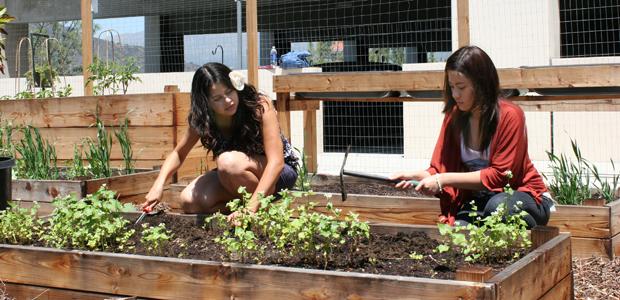A project two-and-a-half years in the making, the Vaquero Greenery is finally on the verge of bearing fruit.
“The garden is about 90 percent complete,” said Abe Barakat, senior accounting clerk and garden volunteer.
In fall of 2011, senior instructional computer lab technician Maria Shufeldt was awarded a $5,000 foundation grant for the purpose of building a campus garden.
Although the garden was not her original idea, Shufeldt orchestrated the grant proposal and analyzed multiple aspects of the project, including cost, risk management, design, location and even philosophy.
“I did my research,” said Shufeldt as she chuckled. “My interest is not just in the production aspect, but also mental health, stress reduction, and community building,” said Shufeldt.
Following the proposal, the Environmental Affairs Committee agreed that the garden should be student-run, and has since been handed over to the Environmental Club to manage.
“The students seemed to be the most available and educationally appropriate group,” Shufeldt said.
While Shufeldt has been the brains of the project, Barakat is the brawn.
“Abe is a doer,” Shufeldt said.
Over the two year period, Barakat built the garden framework and surrounding fence with the help of a few dedicated Environmental Club students. All of whom signed waivers, which freed the school of any injury liabilities.
“Everything was done by hand. We started with nothing,” Barakat said.
Developing the chosen land adjacent to the campus parking structure was a challenge for the volunteers.
To receive school approval, the proposal had to include building a fence along the southern border of the garden, which ends in an abrupt cliff overlooking the tennis courts.
The first eight months of the project were spent clearing brush and building a fence along the escarpment, which entailed digging many holes for fence posts.
“Half of that area is rock.Several of us would get together and we’d start digging,” Barakat said.
“We would use clamshell diggers, I rented an auger and it took a lot of time to get that done.”
The entire fence has since been completed, and it surrounds that garden to protect the plants from grazing animals, humans included, as there is a lock kept on the only gate.
“We don’t ask the school for anything. They just help us out. A gardener ran a water line down for us and the school doesn’t charge us anything for that, so in a sense the school is donating utilities,” Barakat said.
Twenty-one wooden plots were also built from scratch and filled with soil. Several handicap accessible plots are surrounded with tiles, which were donated by Alek Bartrousouf.
Bartousouf is a Glendale College alumn, founder of the Coalition for a Green Glendale and the Monterey Road Eco Community Gardens in Glendale.
“He was very kind to donate his time and recommendations as far as organizing the structure of the garden and bylaws,” Shufeldt said.
There are also several plots raised up about 3 feet high for older patrons who can no longer bend down to care for their crops.
Mulch made of dead oak leaves surrounds the planters where life is finally beginning to sprout. Oats, peas, buckwheat, beefsteak tomatoes, bell peppers, strawberries and a variety of herbs were recently planted by eager Environmental Club students.
“The peas are going to die. They’re just there to enrich the soil. Legumes are really good for fixing nitrogen into soil,” said club member John Shier, who is one of the original volunteers, and, despite taking a break from school, he continues to help out.
While plants are beginning to grow, there are still a few final steps before the garden can be deemed complete. Barakat is still in the process of installing a sink, and the Environmental Club must finish writing the bylaws that will serve as garden guidelines.
However, there are no remaining funds from the grant, and $200 worth of final purchases have come out of Barakat’s pocket, as the club waits for $243 promised by the Associated Students.
“We’re thinking about charging $25 a semester or $50 a year to rent a plot,” said Environmental Club President Jenny Morataya.
The culinary arts, science and welding departments have all shown interest in renting plots. The cafeteria may also reserve a plot, but head chef Nancy Jordan is reserving judgment until more information is available.
Whether or not the Environmental Club can consistently maintain upkeep of the garden will test its dedication, as the group continually changes due to transfers and graduations. The garden may eventually evolve into a more relaxed system as a result.
“My concept was always let’s build a community of gardeners, regardless of what we call ourselves,” Shufeldt said.
“Words like ‘staff, faculty, students,’ lets do away with all that. We’re all learners here and as far as I’m concerned, that’s part of what the garden grows,” Shufeldt said.


